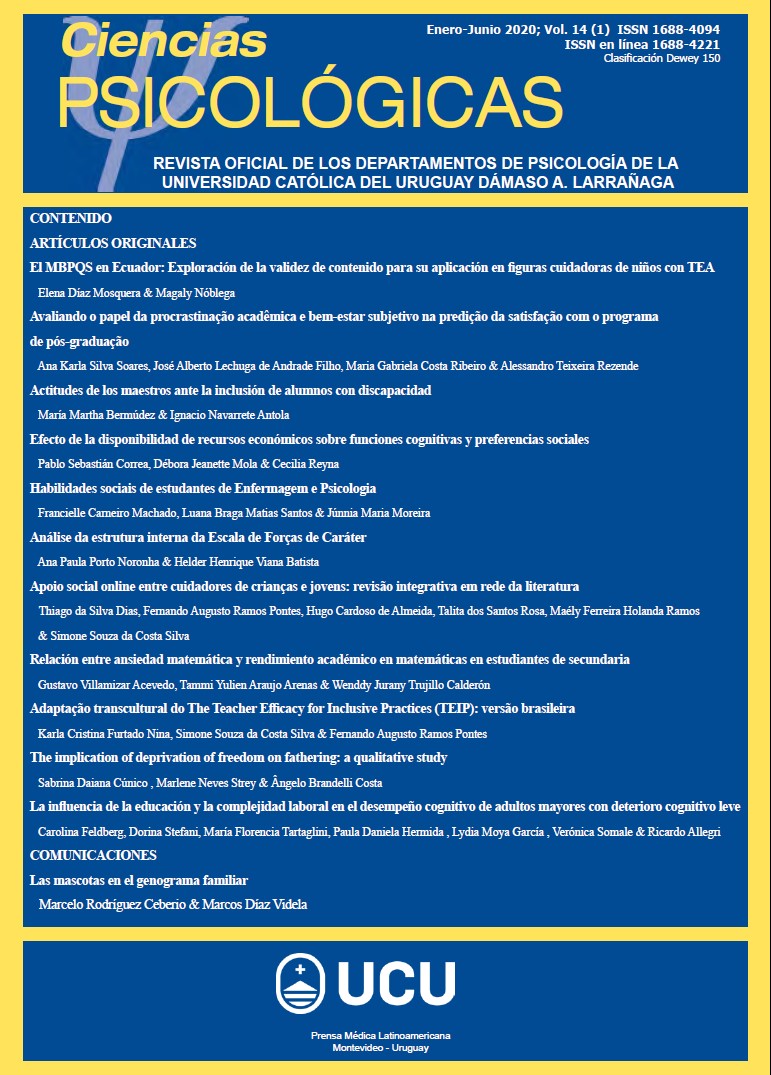Pets in family genogram
DOI:
https://doi.org/10.22235/cp.v14i1.2112Keywords:
companion animal, family dynamics, genogram, family, psychotherapy, petAbstract
The sociocultural changes that occurred in the last decades have elicited a greater permeability to diverse family models and the incorporation of non-human members in the family. In western countries, 90% of people tend to consider their animals as family members. Despite the relevance of this human-animal family configuration, in the clinical practice with families, animals seem to have been overlooked until recently, for example, when a family genogram is performed. Although some authors have started to incorporate animals in this graphic representation, this has appeared to be problematic and little structured. Based in previous research, we provide a guide for the inclusion of animals in the family structure layout, the registry of the information related to it and the assessment and delineation of the family relations that affect its members. Finally, we propose that animals should be included in therapeutic workshops related to genogram.
Downloads
References
Bennett, P. C., & Rohlf, V. I. (2007). Owner-companion dog interactions: Relationships between demographic variables, potentially problematic behaviours, training engagement and shared activities. Applied Animal Behaviour Science, 102(1), 65-84. DOI: 10.1016/j.applanim.2006.03.009
Bennett, R. L., French, K. S., Resta, R. G., & Doyle, D. L. (2008). Standardized human pedigree nomenclature: update and assessment of the recommendations of the National Society of Genetic Counselors. Journal of genetic counseling, 17(5), 424-433.
Bennett, R. L., Steinhaus, K. A., Uhrich, S. B., O'Sullivan, C. K., Resta, R. G., Lochner-Doyle, D., ... & Hamanishi, J. (1995). Recommendations for standardized human pedigree nomenclature. Journal of Genetic Counseling, 4(4), 267-279.
Cain, A. O. (1985). Pets as family members. Marriage & Family Review, 8(3-4), 5-10.
Ceberio, M. R. (2005). Quién soy y de dónde vengo. El genograma: Un viaje por las interacciones y juegos familiares. Buenos Aires: Tres haches.
Charles, N., Davies, C., & Harris, C. (2008). Families in Transition: patterns of family formation and kinship networks. Bristol: The Policy Press.
Cohen, S. P. (2002). Can pets function as family members? Western Journal of Nursing Research, 24(6), 621-638. DOI: 10.1177/019394502320555386
Davis, L., Geikie, G., & Schamess, G. (1988). The use of genograms in a group for latency age children. International Journal of Group Psychotherapy, 38(2), 189–210.
Díaz Videla, M. (2017). Antrozoología y la relación humano-perro. Buenos Aires: iRojo.
Díaz Videla, M., & Olarte, M. A. (2017). Dogs' demographic characteristics associated with relationship differences perceived by the guardian. European Scientific Journal, 13(15), 218-232. DOI: 10.19044/esj.2017v13n15p%25p
European Pet Food Industry Federation (FEDIAF). (2017). Facts and figures. Disponible en: http://www.fediaf.org/who-we-are/european-statistics.html
García, E. (2015). Metaphoric generative genograms: A journey to bring genograms to life through metaphorical components. (Tesis doctoral). Nova Southeastern University, Florida
Global GfK Survey. (2016). Pet Ownership. Recuperado de: https://www.gfk.com/fileadmin/user_upload/country_one_pager/AR/documents/Global-GfK-survey_Pet-Ownership_2016.pdf
Herman, D. (2018). Narratology beyond the human: Storytelling and animal life. New York: Oxford University Press.
Hodgson, K., & Darling, M. (2011). Pets in the family: Practical approaches. Journal of the American Animal Hospital Association, 47(5), 299-305. DOI: 10.5326/JAAHA-MS-5695
Hodgson, K., Darling, M., Freeman, D., & Monavvari, A. (2017). Asking About Pets Enhances Patient Communication and Care: A Pilot Study. INQUIRY: The Journal of Health Care Organization, Provision, and Financing, 54, 1-6. DOI: 10.1177/0046958017734030.
Hodgson, K., Darling, M., Monavvari, A., & Freeman, D. (2018, 11 noviembre). Patient Education Tools: Using Pets to Empower Patients’ Self-care—A Pilot Study. Journal of Patient Experience. DOI: 10.1177/2374373518809008
Johnson, A., & Bruneau, L. (2019). Pets and relationships: How animals help us understand ourselves and our connections with others. En L. Kogan & K. Blazina (Eds.), Clinician's guide to treating companion animal issues (pp. 173-191). Londres, Reino Unido: Academic Press. DOI: 10.1016/B978-0-12-812962-3.00011-3
MacNamara, M., & Moga, J. (2014). The place and consequence of animals in contemporary social work practice. En T. Ryan (Ed.), Animals in social work (pp. 151-166). Londres, Reino Unido: Palgrave Macmillan.
McGoldrick, M. (2016). The genogram casebook: A clinical companion to genograms: Assessment and intervention. New York: WW Norton & Company.
McGoldrick, M., & Gerson, R. (1985). Genogramas en la evaluación familiar. Barcelona: Gedisa.
McGoldrick, M., Gerson, R., & Petry, S. (2008). Genograms: Assessment and intervention. New York: Norton.
Metcalf, L. (2011). The practice of marriage and family therapy. L. Metcalf (Ed.), Marriage and family therapy: A practice-oriented approach (pp. 1-20). New York: Springer Publishing Company.
Meyer, I., & Forkman, B. (2014). Dog and owner characteristics affecting the dog–owner relationship. Journal of Veterinary Behavior: Clinical Applications and Research, 9(4), 143-150. DOI: 10.1016/j.jveb.2014.03.002
Walsh, F. (2009). Human-animal bonds II: The role of pets in family systems and family therapy. Family Process, 48(4), 481-499. DOI: 10.1111/j.1545-5300.2009.01297.x
Downloads
Published
How to Cite
Issue
Section
License
Copyright (c) 2020 Universidad Católica del Uruguay

This work is licensed under a Creative Commons Attribution 4.0 International License.
















